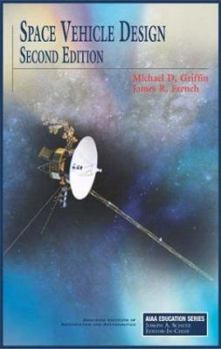Space Vehicle Design, Second Edition
Select Format
Select Condition 
Book Overview
The second edition of this text continues to fulfil the book's original goal in linking and integrating many disciplines relevant to the field of space systems engineering. It contains an additional... This description may be from another edition of this product.
Format:Hardcover
Language:English
ISBN:1563475391
ISBN13:9781563475399
Release Date:February 2004
Publisher:AIAA (American Institute of Aeronautics & Ast
Length:665 Pages
Weight:2.35 lbs.
Dimensions:1.3" x 6.4" x 9.2"
Customer Reviews
2 ratings
A good text but very general
Published by Thriftbooks.com User , 16 years ago
I used this book in a space vehicle design class. If you intend to use this text to gain a broad understanding of the basic design considerations for space vehicles, I believe you will be satisfied. If, however, you would like to go into depth regarding rocket propulsion, orbital mechanics, structural/vibration analysis, reentry, etc. look for a text which is devoted to those topics. This text does cover such topics as well as others but is lacking in detail. There are some good examples throughout each chapter and problems at the end of each chapter.
difficult design constraints
Published by Thriftbooks.com User , 16 years ago
To an engineering reader, the book gives some appreciation of why it is so expensive in money and time to build a new spacecraft. The text gives a systems-level view of the different components such a craft is likely to need. A propulsion system. Attitude control. Navigation. Communications. All of these must work for the craft to be viable. The chapters go into the numerous constraints often encountered. Mass is the most critical. Very costly to launch these spacecrafts. And the lifting capacity of whatever launch vehicle is chosen can be one of the major constraints. Power for the various systems is minimal. Perhaps solar panels can be used. Or a radio isotope thermal generator. But solar panels aren't typically viable for missions to the outer solar system. Whatever is chosen, you have only a trickle of power to work with. Then how to communicate with Earth? The gain on the craft's antenna for transmission and reception is limited. Amazing that any spacecrafts are successful.





